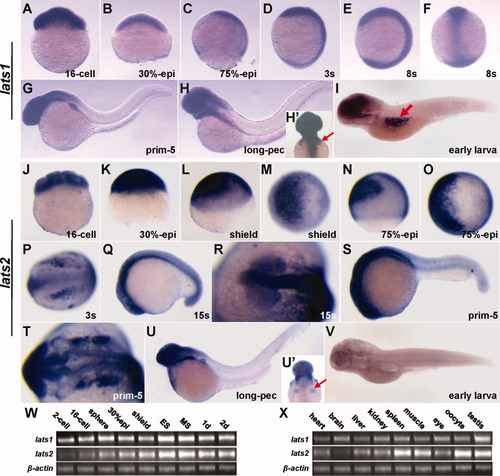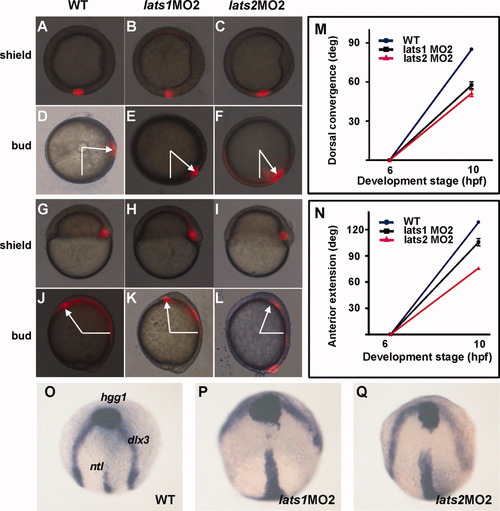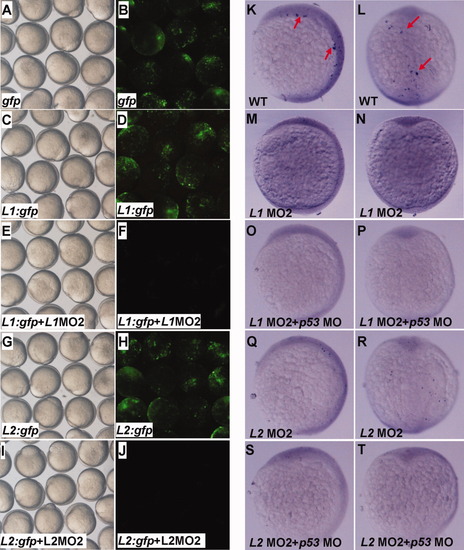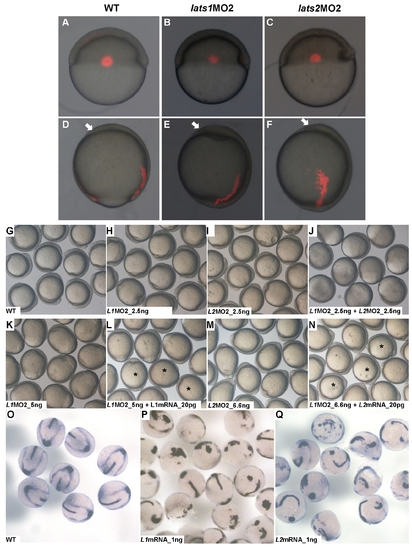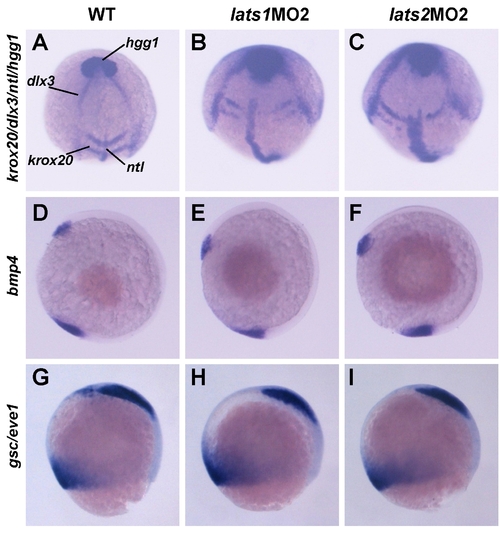- Title
-
Comparative expression of zebrafish lats1 and lats2 and their implication in gastrulation movements
- Authors
- Chen, C.H., Sun, Y.H., Pei, D.S., and Zhu, Z.Y.
- Source
- Full text @ Dev. Dyn.
|
Expression patterns of lats1 and lats2 during development and in adult tissues of zebrafish. A-I: Expression analysis of lats1 by whole-mount in situ hybridization (WISH) in embryogenesis. A: lats1 is maternally expressed as shown by the strong staining in 16-cell stage embryo. B-F: lats1 is ubiquitously expressed during later development until mid-somitogenesis. G,H: From prim-5 to long-pec stage, lats1 is prominently expressed in the anterior structures such as the brain and pectoral fins (indicated by red arrow in panel H′). I: At early larva stage, as indicated by red arrow, lats1 is remarkably expressed in the gas bladder. J-V: Expression analysis of lats2 by WISH in embryogenesis. J,K: Similar to lats1, lats2 is likewise maternally and ubiquitously expressed before 30%-epiboly. L-T: From shield stage, lats2 begins to present territory-specific expression patterns, besides a low-level ubiquitous expression throughout these developmental stages. L-O: From shield (L,M) to mid-gastrula (N,O) stage, lats2 probe strongly labeled the non-neural ectoderm cells. P-T: At the three-somite stage (P), lats2 is mainly expressed in the neural crest cells and the primordial CNS (central nervous system) cells; from mid-somitogenesis (Q,R) to prim-5 (S,T) stage, lats2 is notably expressed in the eyes and all the parts of encephalon as well as the neural crest derivatives. U: At long-pec stage, lats2 is prominently expressed in the anterior structures such as the brain and pectoral fins (indicated by red arrow in panel U′). V: At the early larva stage, in contrast to lats1, there is no obvious expression of lats2 in the gas bladder. W: By Reverse transcription polymerase chain reaction (RT-PCR) analysis, lats1 is ubiquitously expressed from the two-cell to long-pec stage, and in comparison to lats1, lats2 shows weaker expression at 2-cell stage and stronger expression from early-somitogenesis. X: In different tissues of adult, lats1 is almost ubiquitously expressed and lats2 is more prominently expressed in the spleen, muscle and gonads. Embryos in A-E,J-L,N are lateral view with dorsal to the right; embryo in F is dorsal view with animal pole to the top; embryos in M,O are animal pole view with dorsal to the right; embryos in P,R,T are dorsal view with anterior to the left; embryos in G-I,Q,S,U,V are lateral view with anterior to the left; embryos in H′,U′ are dorsal view with anterior to the top. |
|
lats1 and lats2 morphants showed convergence extension defects during gastrulation. Embryos were injected with indicated morpholino (MO)and kaede mRNA. A-L: The Kaede protein was photoconverted at shield stage (6 hours postfertilization [hpf]) laterally to determine dorsal migration (A-F; animal pole view, dorsal to right) and dorsally to determine anterior extension (G-L; lateral view, dorsal to right). Images show photoconverted cells directly after activation (A-C,G-I), and at bud stage (D-F,J-L). White arrows indicated dorsal convergence (D-F; n = 5, 9, and 9, respectively) and anterior extension (J-L; n = 4, 7, 8, respectively). M,N: Graphs that compare the dorsal convergence (M) and anterior extension (N) of labeled cell groups in the embryos at bud stage were shown in (D,J: control, blue), (E,K: lats1MO2, black), (F,L: lats2MO2, red). Dorsal convergence and anterior extension were quantified by the position of the labeled cells at the indicated stage. The mean and standard deviation (SD) were shown. The results shown in A-L represent the result of one experiment. The doses of kaede mRNA, lats1MO2 and lats2 MO2 are 500 pg, 3.3 ng, and 5 ng per embryo, respectively. O-Q: The molecular description of defective convergence extension (CE) movements in lats1 and lats2 morphants. H,I: All the embryos were at the three- to four-somite stage. In the lats1 (H) and lats2 (I) morphants, the posters labeled by hgg1 were far behind the anterior border of the neural plates that was labeled by dlx3. G,H: The neural plates indicated by the distance between dlx3 labeling in lats1 (H) and lats2 (I) morphants were much wider than that in wild-type embryos (G). Embryos in (A-F) were animal pole view with dorsal to the right, embryos in (G-L) were lateral view with dorsal to the right, and embryos in (O-Q) were dorsal view with anterior to the top. deg, degree. PHENOTYPE:
|
|
The morpholinos (MOs) used in the present study are effective and do not result in nonspecific apoptosis. A-J: lats1MO2 and lats2MO2 used in the present study are effective. The strong expression of lats1:gfp or lats2:gfp fusion protein could be effectively blocked by co-injection of lats1MO2 or lats2MO2. The doses of gfp, lats1:gfp, and lats2:gfp plasmids are 100 pg/embryo respectively; the dose of lats1MO2 is 5 ng/embryo, and lats2MO2 is 6.6 ng/embryo. K-T: The lats1 and lats2 morphants did not show any nonspecific cell apoptosis at four-somite stage. KN,Q,R: There were no increased but even slightly decreased apoptosis in the lats1 (M,N) or lats2 (Q,R) morphants than the wild-type embryos (K,L) at four-somite stage. Embryos in K,M,O,Q,S are lateral view with dorsal to the right, and embryos in L,N,P,R,T are dorsal view with anterior to the top. Red arrows in K,L indicate the TUNEL (terminal deoxynucleotidyl transferase-mediated deoxyuridinetriphosphate nick end-labeling) staining signals which reflect the cell apoptosis. The doses of lats1MO2, lats2MO2, and p53MO are 5 ng, 6.6 ng, and 2.2 ng per embryo, respectively. L1:gfp, lats1:gfp; L2:gfp, lats2:gfp; L1MO2, lats1MO2; L2MO2, lats2MO2. PHENOTYPE:
|
|
lats1MO2 and lats2MO2 used in the present study have synergistic effect, and the morphants could be partially rescued by low-dose overexpression of the corresponding lats gene. A-F: Migration of the lateral cell groups during gastrulation labeled by photoactivation of Kaede in the lateral blastopore of wild-type (A,D), the lats1 morphant (B,E) and lats2 morphant (C,F) embryos. A-C show the labeled cell groups at the onset of gastrulation, while D-F show the labeled arrays at bud stage (10 hours postfertilization [hpf] in D, and 10.5 hpf in E and F). The doses of kaede mRNA, lats1MO2, and lats2 MO2 are 500 pg, 3.3 ng, and 5 ng per embryo, respectively. H,I: The threshold concentrations of lats1MO2 and lats2MO2 were determined as 2.5 ng/embryo respectively. J,K,M: Relative to the single lats1MO2 morphants (K, 5 ng/embryo) or lats2MO2 (M, 6.6 ng/embryo) morphants, co-injection of lats1MO2 (2.5 ng/embryo) and lats2MO2 (2.5 ng/embryo) showed much severer phenotypes (J), even though the total injection dose (5ng/embryo) was not higher than the dose of either lats1MO2 (K) or lats2MO2 (M). The result indicated that lats1MO2 and lats2MO2 had synergistic effect, supporting the effectiveness and specificity of MOs. G: Compared with wild-type embryos (G), the living lats1 morphants (K) appeared deficient in epiboly and extension movement (n = 27). L: When co-injected with lats1 mRNA, around 46.7% (14 of 30 injected embryos) of the lats1 morphants were rescued (stars indicated wild-type like embryos). M: A total of 75% (24 out of 32) of the lats2 morphants were somewhat elongated along the AP (anterior-posterior) axis, which indicated defect in gastrula movement. N: Co-injection of lats2 mRNA showed partial rescue, as 43.9% of the injected embryos (15 out of 35) were wild-type like with roundish shape (stars indicated wild-type like embryos). The partial rescue of lats1/lats2 morphants by their corresponding mRNA further revealed the specificity of MOs. O-Q: dlx3/ntl/hgg1 labeling of wild-type embryos (O), and the embryos overexpressing lats1 (P), and lats2 (Q). Of interest, the lats1 and lats2 highly overexpressed embryos also showed defects in gastrulation movements at percentages of 73.58% (78 of 106, lats1 mRNA) and 50% (12 of 24, lats2 mRNA), respectively. Therefore, to get a full rescue of lats1/lats2 morphants by injecting their corresponding mRNA is somehow difficult. The concentrations injected were shown in each corresponding panel. L1MO1, lats1 MO1; L1MO2, lats1 MO2; L2MO1, lats2 MO1; L2MO2, lats2 MO2; L1mRNA, lats1 mRNA; L2mRNA, lats2 mRNA. PHENOTYPE:
|
|
The embryos stained by hgg1/dlx3/ntl were at a comparable stage, and lats2 does not show any obvious relation to bmp4 in early development. A-C: The embryos defective in gastrulation movements were age-comparable to the wild-type embryos, as the embryos also showed normal labeling of krox20 at rhombomere 3 and 5 (B,C), which only appear from 3-somite stage. D-F: Expression of bmp4 at 4-somite stage in wild-type (D), lats1 morphant (E), and lats2 morphant (F) embryos. As the specific stronger expression region of lats2 during gastrulation is similar to that of bmp4, which suggests the possible involvement of lats2 activity with bmp4 pathway. However, the expression of bmp4 in the four-somite stage lats1/lats2 morphants was nearly unchanged when compared with that in wild-type embryos. G-I: In accordance with this, at 75%-epiboly stage, ventral mesoderm specific eve1 labeling and the dorsal anterior mesoderm specific gsc labeling did not show any significant difference between the wild-type embryos and the lats1/2 morphants. These indicate that there may be a very weak, if any, relation between lats1/2 and bmp4 in the early development of zebrafish. Embryos in A-C are dorsal view with anterior to the top, and embryos in D-I are lateral view with dorsal to the right. |

Unillustrated author statements PHENOTYPE:
|

